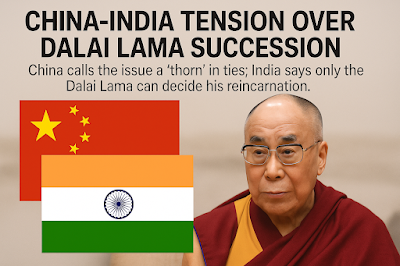In the intricate landscape of South Asian geopolitics, one issue continues to stir quiet but deep-seated tensions between two of the world’s most populous countries—China and India. At the heart of this friction lies a spiritual and political matter that transcends borders: the succession of the 14th Dalai Lama. As His Holiness the Dalai Lama nears 90 years of age, the question of who will succeed him has evolved into a matter of international controversy, nationalism, and spiritual legitimacy.
 |
CHINA-INDIA TENSION OVER DALAI LAMA SUCCESSION |
This article explores the full story behind the China–India tension over the Dalai Lama’s future, the historical context, the current political positioning, and what this means for the region and the world.
Who Is the Dalai Lama?
The Dalai Lama is the spiritual leader of Tibetan Buddhism, believed to be the reincarnation of Avalokiteśvara, the Bodhisattva of compassion. Traditionally, after a Dalai Lama dies, his reincarnation is identified through signs, visions, and rituals conducted by senior Tibetan monks. The 14th and current Dalai Lama, Tenzin Gyatso, was born in 1935 and has served as the face of Tibetan identity since his childhood enthronement.
Following the 1959 Tibetan uprising against Chinese rule, the Dalai Lama fled to India, where he has lived in exile in Dharamshala, Himachal Pradesh, ever since. From there, he established the Tibetan government-in-exile, which continues to advocate for Tibetan autonomy and religious freedom.
The Core Conflict: Who Controls Reincarnation?
The core issue is simple in premise but deeply complex in reality: who gets to decide the next Dalai Lama?
- Tibetan tradition, followed by the current Dalai Lama and his followers, states that only senior Buddhist monks, following spiritual practices, can recognize the reincarnated soul.
- China, on the other hand, claims the right to control the selection process, arguing that even spiritual reincarnations in Tibet must receive state approval.
This contradiction has created a volatile mix of religious authority and political control, leading to friction not just between China and Tibetans, but now, between China and India.
Why It’s a Problem for China
From Beijing’s perspective, Tibet is an inseparable part of China, and the Dalai Lama is seen not as a peaceful monk, but as a separatist figure. China has consistently tried to weaken the Dalai Lama’s global influence and integrate Tibetan Buddhism under state authority.
To that end, China passed a 2007 regulation stating that all Tibetan lamas must be approved by the government, including any reincarnated Dalai Lama. Beijing insists that its own approved successor will be the legitimate Dalai Lama, regardless of what the religious community or the Dalai Lama himself declares.
India’s Involvement
India’s role is central to this story for several reasons:
- Exile Base: India has hosted the Dalai Lama since 1959, along with thousands of Tibetan refugees.
- Tawang, Arunachal Pradesh: This northeastern Indian town is deeply significant. The 6th Dalai Lama was born here, and the current Dalai Lama has hinted that his successor may be reborn in Tawang—a place that China controversially claims as part of “South Tibet.”
- Strategic Counterweight: India’s tacit support of the Tibetan cause has served as a diplomatic counterbalance to China, especially amid increasing border disputes along the Line of Actual Control (LAC).
The July 2025 Flashpoint
On July 13, 2025, tensions escalated again when a Chinese Foreign Ministry spokesperson called the Dalai Lama succession issue a “thorn” in India–China relations. This statement came ahead of India’s External Affairs Minister S. Jaishankar’s scheduled visit to Beijing, igniting fresh diplomatic unease.
According to Chinese officials, any suggestion that the next Dalai Lama could be born in India is a violation of Chinese sovereignty. Conversely, Indian officials assert that:
- Only the Dalai Lama has the right to decide his reincarnation.
- Religious freedom must be protected, and China has no right to interfere in Tibetan spiritual practices.
- Tawang is sovereign Indian territory, and Chinese objections are unfounded.
This war of words reflects not just a religious disagreement, but a larger power struggle.
International Perspectives
The global community is watching closely:
- The United States, European Union, and various human rights organizations have publicly supported the Dalai Lama’s right to decide his successor.
- China’s plan to select its own Dalai Lama is seen as a move to undermine Tibetan identity and consolidate state control.
- Several nations have passed resolutions condemning religious repression in Tibet, although most governments stop short of directly challenging China.
What Happens If Two Dalai Lamas Are Named?
The most likely scenario is that two different Dalai Lamas will be named:
- One chosen by senior Tibetan monks, possibly born and raised in India.
- Another appointed by the Chinese state, raised and trained within China’s borders.
This would split the Tibetan Buddhist community across the world and create massive diplomatic ripples.
- Tibetan Buddhists outside China are expected to reject Beijing’s version.
- Within China, propaganda and restrictions will ensure people follow the state-approved Dalai Lama.
- This religious division may mirror the political divide between democratic India and authoritarian China.
India’s Diplomatic Tightrope
India has historically been cautious about the Tibet issue to avoid direct confrontation with China. However, in recent years, especially after the 2020 Galwan Valley clash, India’s posture has shifted. There is growing public and political support in India to stand up against Chinese aggression—including on spiritual matters.
India’s government still walks a tightrope:
- It doesn’t officially recognize the Tibetan government-in-exile as sovereign.
- But it continues to protect the Dalai Lama, allow Tibetan communities to thrive, and resist Chinese influence in the region.
What’s at Stake?
This is not just a spiritual debate—it’s a battle over:
- Cultural identity
- Sovereignty
- Geopolitical dominance
If the Dalai Lama’s reincarnation is confirmed in India, and India recognizes him, it could:
- Deepen diplomatic tensions with China.
- Spark protests in Tibet.
- Trigger broader discussions about religious freedom vs. authoritarian control.
- Strengthen India’s image as a protector of spiritual liberty.
